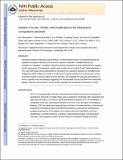Striatal circuits, habits, and implications for obsessive–compulsive disorder
Author(s)
Monteiro, Patricia; Mallet, Luc; Feng, Guoping; Burguiere, Eric; Graybiel, Ann M.
DownloadFeng_Striatal circuits.pdf (311.4Kb)
PUBLISHER_CC
Publisher with Creative Commons License
Creative Commons Attribution
Terms of use
Metadata
Show full item recordAbstract
Increasing evidence implicates abnormalities in corticostriatal circuits in the pathophysiology of obsessive–compulsive disorder (OCD) and OC-spectrum disorders. Parallels between the emergence of repetitive, compulsive behaviors and the acquisition of automated behaviors suggest that the expression of compulsions could in part involve loss of control of such habitual behaviors. The view that striatal circuit dysfunction is involved in OC-spectrum disorders is strengthened by imaging and other evidence in humans, by discovery of genes related to OCD syndromes, and by functional studies in animal models of these disorders. We highlight this growing concordance of work in genetics and neurobiology suggesting that frontostriatal circuits, and their links with basal ganglia, thalamus and brainstem, are promising candidates for therapeutic intervention in OCD.
Date issued
2014-09Department
Massachusetts Institute of Technology. Department of Brain and Cognitive Sciences; McGovern Institute for Brain Research at MITJournal
Current Opinion in Neurobiology
Publisher
Elsevier
Citation
Burguiere, Eric, Patricia Monteiro, Luc Mallet, Guoping Feng, and Ann M Graybiel. “Striatal Circuits, Habits, and Implications for Obsessive–compulsive Disorder.” Current Opinion in Neurobiology 30 (February 2015): 59–65.
Version: Author's final manuscript
ISSN
09594388